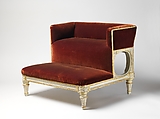Bed steps (Marchepied de lit)
possibly by Jean Baptiste Boulard French
French eighteenth-century beds in the homes of the highest echelons of society tended to be lofty, as it was customary to pile them with three or more mattresses filled with straw, wool, horsehair or feathers. The piled-up bedding created a considerable height, as is indicated by a Scottish traveler, the poet Tobias Smollett (1721-1771) who noted in 1766, “French beds are so high, that sometimes one is obliged to mount them by the help of steps.”
Stepstools or bed steps were used to ascend safely into bed, as is seen in contemporary illustrations. Known as a marchepied de lit, such bed steps were often made to match the frame of the bed next to which they were used and would be upholstered in the same material as the bed hangings. These particular bed steps consist of two upholstered treads above straight rails which are carved with beading while the two sides are pierced with an oval. The corners directly above the short circular tapered and fluted legs are decorated with paterae. Based on similarities with bed steps by Jean-Baptiste Boulard on display at the château de Versailles, it is possible that these were made by the same menuisier.
Due to rights restrictions, this image cannot be enlarged, viewed at full screen, or downloaded.

